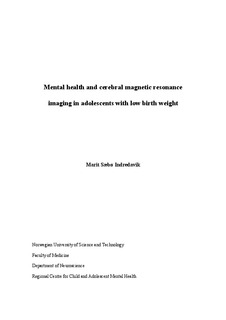| dc.contributor.author | Indredavik, Marit Sæbø | nb_NO |
| dc.date.accessioned | 2014-12-19T14:16:46Z | |
| dc.date.available | 2014-12-19T14:16:46Z | |
| dc.date.created | 2006-03-01 | nb_NO |
| dc.date.issued | 2005 | nb_NO |
| dc.identifier | 125873 | nb_NO |
| dc.identifier.isbn | 82-471-7257-7 | nb_NO |
| dc.identifier.uri | http://hdl.handle.net/11250/263147 | |
| dc.description.abstract | VLBW adolescents
We found that the VLBW adolescents had specific emotional and cognitive traits. Some of them fit with psychiatric concepts and others do not. They had an increased risk of developing psychiatric symptoms and disorders compared with controls, especially attention deficit, anxiety and relational problems affecting their social skills and overall functioning. Academic achievement was reduced. The attention problems were widespread, but only a minority fulfilled the diagnostic criteria of Attentiondeficit/ hyperactivity disorder. Increased prevalence of anxiety symptoms and disorders may be due to a number of factors, comprising both biological/neuroendocrine and psychosocial mechanisms. The peer problems and deficits in social skills may indicate specific difficulties in relating and adjusting to others, with deficits in comprehending the subtle cues of social relations. The implication of thought problems reported by teachers is unclear. Adolescents with birth weight ≤ 1000 g showed a tendency towards more psychiatric disorders than those with birth weight between 1000 and 1500 g. The lack of gender differences demonstrates that prematurity exceeds the usual effect of gender regarding vulnerability for developing psychiatric symptoms.
We found that the VLBW adolescents perceived self-esteem and quality of life as others did at the age of 14. However, parents reported functional disadvantages and reduced quality of life measures for their adolescents. The parents worried more for their children’s functioning and well-being, especially if the child had a psychiatric disorder or cerebral palsy. Still, being born VLBW did not influence the warmth in the parent-child relationship, nor did the parents have more mental health problems.
As the association between VLBW and psychiatric problems could not be explained by SES or the parents’ mental health, a biological cause-effect relationship seems plausible. The frequency of cerebral MRI abnormalities was higher in the VLBW group than in the control group. Furthermore, ADHD symptoms were associated with white matter reduction and thinning of the corpus callosum, while other psychiatric symptoms were not associated with MRI abnormalities. These results support the hypothesis of a specific (“pure”) type of ADHD with a dominant neurological aetiology, while interacting psychosocial experiences play a minor part. Our study indicates that being born VLBW involves a biological vulnerability with increased risk of psychiatric symptoms.
SGA adolescents
Although every fifth SGA adolescent had psychiatric symptoms, assessed by interview, the prevalence of symptoms and disorders did not differ significantly from controls. Yet, screening questionnaires displayed more behavioural problems, lowered social competence and a tendency towards attention deficit/hyperactivity. Teachers reported withdrawal and thought problems, while academic performance did not differ from controls. Boys had more attention and externalizing problems than girls.
Generally, on psychiatric measures, the term SGA group seemed to fall inbetween the VLBW and the control group, resembling the control group more than the VLBW group.
The SGA adolescents and their parents reported self-esteem and quality of life as in the control group. Being born SGA at term did not influence the warmth in the parent-child relationship, and the parents did not have more mental health problems than others. The frequency of cerebral MRI abnormalities in the SGA group did not differ from the control group, and no associations were found between psychiatric symptoms and MRI abnormalities. | nb_NO |
| dc.language | eng | nb_NO |
| dc.publisher | Det medisinske fakultet | nb_NO |
| dc.relation.ispartofseries | Doktoravhandlinger ved NTNU, 1503-8181; 2005:183 | nb_NO |
| dc.relation.ispartofseries | Dissertations at the Faculty of Medicine, 0805-7680; 261 | nb_NO |
| dc.relation.haspart | Indredavik, MS; Vik, T; Heyerdahl, S; Kulseng, S; Fayers, P; Brubakk, A-M. Psychiatric symptoms and disorders in adolescents with low birth weight. Arch Dis Child Fetal Neonatal Ed. 89: F445-50, 2004. | nb_NO |
| dc.relation.haspart | Indredavik, MS; Vik, T; Heyerdahl, S; Kulseng, S; Brubakk, A-M. Psychiatric symptoms in low birth weight adolescents, assessed by screening questionnaires. Eur Child Adolesc Psychiatry. 14: 226-36, 2005. | nb_NO |
| dc.relation.haspart | Indredavik, MS; Vik, T; Heyerdahl, S; Romundstad, P; Brubakk, A-M. Low-birthweight adolescents: Quality of life and parent–child relations. Acta Paediatr. 94: 1295-1302, 2005. | nb_NO |
| dc.relation.haspart | Skranes, JS; Martinussen, M; Smevik, O; Myhr, G; Indredavik, MS; Vik, T; Brubakk, A-M. Cerebral MRI findings in very-low-birth-weight and small-for-gestational-age children at 15 years of age. Pediatr Radiol. 35: 758-65, 2005. | nb_NO |
| dc.relation.haspart | Indredavik, MS; Skranes, JS; Vik, T; Heyerdahl, S; Romundstad, P; Brubakk, A-M. Low-Birth-Weight Adolescents: Psychiatric Symptoms and Cerebral MRI Abnormalities. Pediatr Neurol. 33: 259-266, 2005. | nb_NO |
| dc.subject | Infant | en_GB |
| dc.subject | low birth weight | en_GB |
| dc.subject | magnetic resonance imaging | en_GB |
| dc.subject | adolescent | en_GB |
| dc.subject | mental health | en_GB |
| dc.subject | mental disorders | en_GB |
| dc.subject | MEDICINE | en_GB |
| dc.title | Mental health and cerebral magnetic resonance imaging in adolescents with low birth weight | nb_NO |
| dc.type | Doctoral thesis | nb_NO |
| dc.contributor.department | Norges teknisk-naturvitenskapelige universitet, Det medisinske fakultet | nb_NO |
| dc.description.degree | dr.med. | nb_NO |
| dc.description.degree | dr.med. | en_GB |
